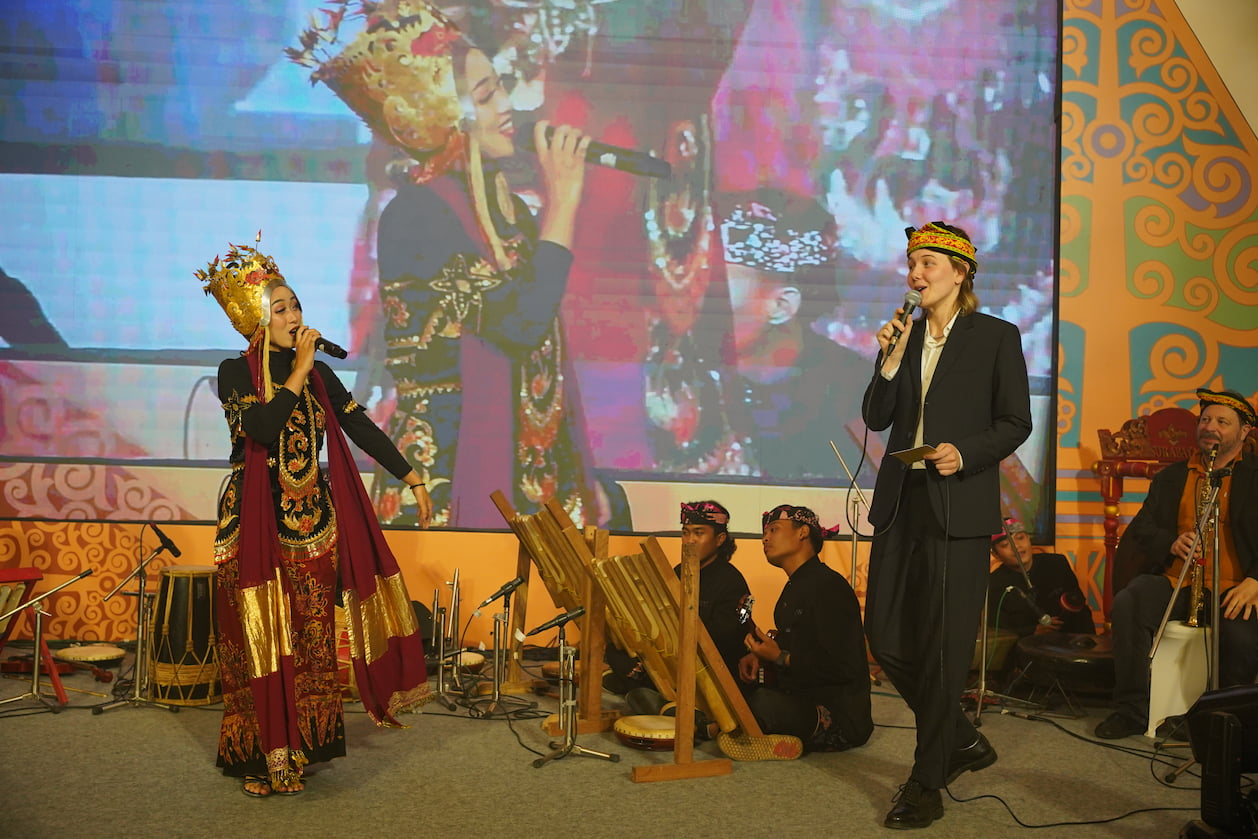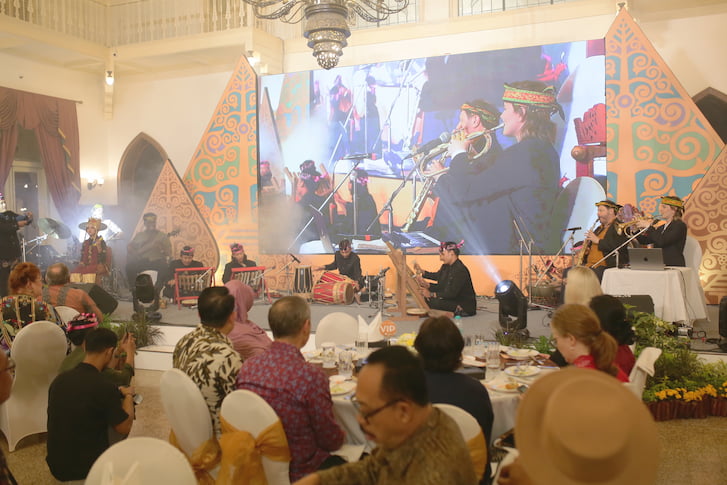WA’s creative industries are at the heart of bilateral investment and trade with Southeast Asia, says Michael Carter, Head of CCIWA’s International and Trade and Investment Centre.
The sector was in the spotlight at the Indonesia Connect Roadshow in September, particularly at a Cultural Connect Dinner which brought together WA Government and industry representatives with cultural partners from East Java.
The dinner showcased partnerships formed between WA and Indonesia and looked towards new possibilities for collaboration, and included a performance by the WA Academy of Performing Arts and Sekolah Tinggi Kesenian Wilwakitka, a higher education institution of arts in Surabaya.

The trade mission included a Cultural Connect Dinner, featuring a performance by the WA Academy of Performing Arts and Indonesian higher education institution Sekolah Tinggi Kesenian Wilwakitka. Photos courtesy of the Department of Jobs, Tourism, Science and Innovation / Invest and Trade WA.
Carter says the roadshow demonstrated the importance of doing business with cultural ties.
“Building people-to-people linkages and understanding culture enables businesses to build relationships to do business in Southeast Asia,” he says.
“The way Asian business works is about building relationships first, establishing trust and having mutual understanding, then getting down to business.
“Creative industries are also highly engaged with digital technology platforms and tools to connect cultures with wider audiences.”
Southeast Asians are rapidly adopting digital technology. In 2020, 40 million new users joined the internet, compared to 100 million between 2015 and 2019, and 70% of the region’s population was online.
Poised for growth
The Federal Government’s investment strategy with Southeast Asia, launched during the roadshow, identifies creative industries as one of 10 priority sectors for greater trade and investment potential.
Many Southeast Asian countries, including Singapore, Thailand and Vietnam, have adopted national strategies for creative industries development and established dedicated agencies to help drive and support the sector.
As Southeast Asia’s middle class increases and the growing appetite for Western culture continues, the Government anticipates more demand for cultural experiences, opening opportunities for Australian businesses and creatives.
As a single market, the Association of Southeast Asian Nations (ASEAN) is WA’s second largest trading partner.
State of WA’s creative economy
 The most recent analysis of WA’s creative economy in 2019 reports that scope for growing the State’s creative industries is strong, particularly in intellectual property (IP) development and creative services exports.
The most recent analysis of WA’s creative economy in 2019 reports that scope for growing the State’s creative industries is strong, particularly in intellectual property (IP) development and creative services exports.
WA’s creative services exports have grown steadily by an average of 8.4% per year from 2013 to 2018, worth $175.9m.
Computer and information services accounted for 82% of exports from the sector in 2018. IP development had the largest growth for WA creative services exports, by 38% per year.
In 2018, WA accounted for 3.2% of Australia’s (fourth largest share by State) creative industries export services and 2.6% of the State’s total services exports, reflecting major potential for growth.
A national project named four WA regions as ‘creative hotspots’: Albany-Denmark, Busselton, Fremantle and Geraldton. Factors that contribute to these regions being hives of creativity include:
- Creative practitioners reside in these areas for lifestyle and community reasons, particularly in Albany-Denmark and Busselton.
- Strong local government and community support for creative pursuits.
- Other industries such as tourism, events/festivals and hospitality fuel local creative ecosystems.
- Creativity is embedded in the community’s cultural fabric, particularly in Fremantle.
- Strong local understanding of arts entrepreneurship, innovative business models for artists, and integrated connection with other small businesses and incubators.
- Depending on the region, creative occupations and activities vary among cultural production (such as visual arts, crafts, sculpture, performance and theatre, live music, film making and television news production, and creative writing and publishing) and creative services (graphic and web design, advertising, architecture, photography, and software and application programmers).
- Connection and integration with local Aboriginal communities and creatives.
Showcasing Aboriginal culture
In early 2023, the Australian Government committed to “renew and revive Australian arts, entertainment and cultural sector” through the National Cultural Policy ‘Revive’.
Aboriginal culture is the oldest living culture in the world; showcasing First Nations culture is at the core of Revive.
Federal Minister for the Arts Tony Burke says the plan creates “a place for every story and a story for every place”.
“Our artists are creators and workers. This sector is essential for our culture and for our economy,” he says.
“As the sector recovers from years of neglect followed by the tough pandemic period, Revive will set the arts sector on a new trajectory with fresh momentum.”
The plan commits an additional $200m of funding over four years, with the aim of providing greater strategic oversight and engagement across the sector.
It includes establishing Creative Australia, launched in August, with four new sub-bodies dedicated to giving First Nations people autonomy over decisions and investments, music, writers and supporting creative practitioners with workplace relations issues.
In Perth, the Federal and State Governments are developing an Aboriginal Cultural Centre to showcase and celebrate First Nations arts and cultures. It is targeted for completion by Q4 FY2028.
Ripe for investment
WA’s creative industries is a key sector promoted on WA Investments* – a website that connects investors across the world with WA-based investment-ready projects.
“WA Investments now showcases 55 projects across WA, valued at more than $8 billion,” Carter says.
“Six of those projects are in the creative industries, tourism and events industries, and reflect the creative diversity of our State with a pool of talent and skill of an exceptional calibre.”
Carter says WA has strong potential to service increasing demand from Southeast Asia and attract investment in:
- Film and television: WA has high quality film and television production facilities and the State’s producers have a strong track record of success in international markets.
- Music: WA has a vibrant music scene, with many successful musicians and bands.
- Gaming: The gaming industry is growing rapidly in Southeast Asia and there are opportunities for WA gaming companies to develop and publish games for the region.
- Design: WA has several talented designers working in a variety of fields, including fashion, graphic design and interior design.
*WA Investments is a collaboration between CCIWA and Invest and Trade WA.
If you are looking for support or advice in business, investment or trade, contact our experienced International Trade and Investment Centre team at [email protected].






